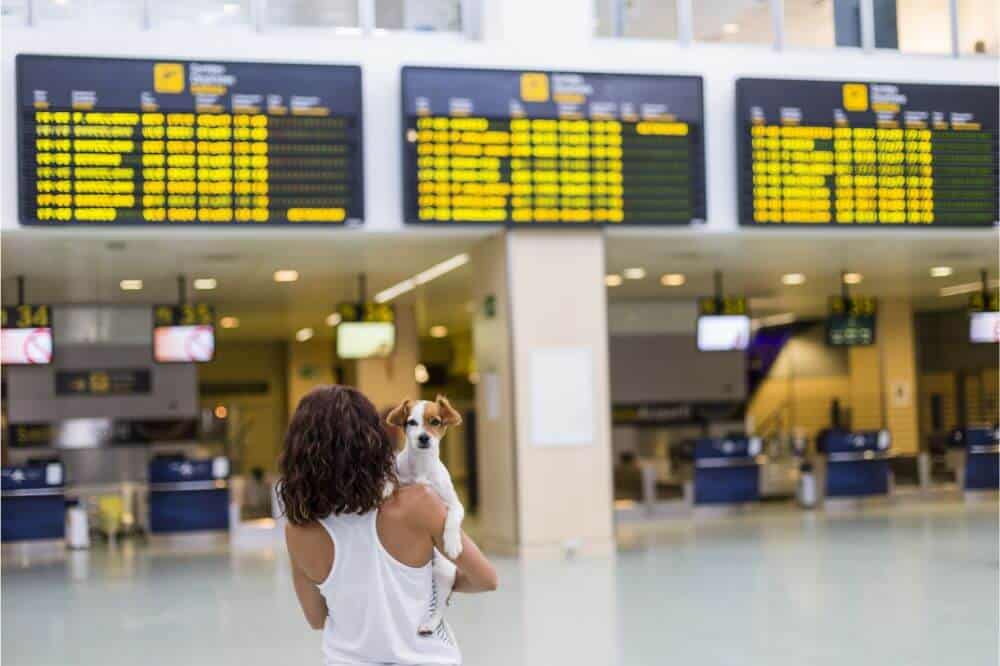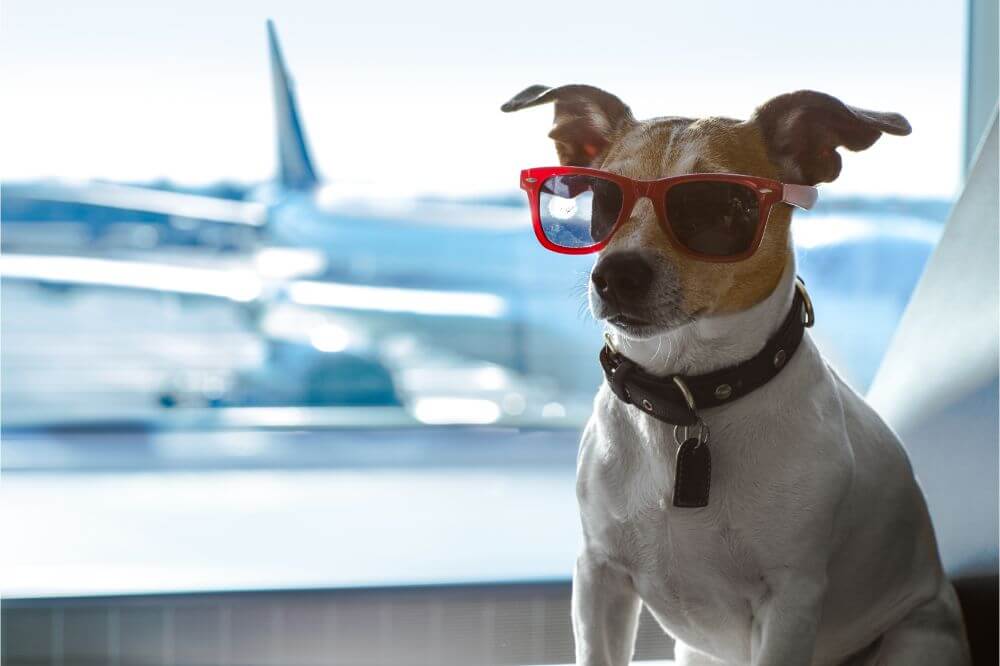Last Updated on October 14, 2024 by Dawn Head
If you are planning to travel somewhere by airplane, chances are you are going for at least a few days. You could leave your precious dog at a boarding kennel, but those places are expensive and often don’t give your dog the attention you are used to providing them.
Whatever the case, dogs are family, which means that you probably want to take Fido along with you for the journey. That said, there are some very important things that you need to know about airplane travel with a dog.
Here I explain how to travel with a dog on a plane with help from the Humane Society and my friend Judy who frequently travels with her small dog from Phoenix to Milan and back. Her dog is small and fits under the seat in front of her.
Tips for Traveling with a Dog on a Plane
Here advice and a few tips for you to follow when you are looking to take your dog traveling with you.
Learn airline pet restrictions. Many airlines have a maximum weight for the dog carrier and the dog together, not just the dog’s weight.
Size Matters
Something you want to consider before you start thinking about taking your dog with you is how large the dog is.
The reason for this is because the size of the dog will determine whether or not the pet can sit with you in the passenger cabin or if it has to travel below in the cargo hold.
Each airline has specific guidelines in this regard, so be sure to do your research. Generally speaking, most airlines will allow small dogs to be in the passenger cabin in a carrier, but larger dogs will need to be in the cargo hold.
If you are allowed to take the dog into the passenger cabin, be aware that removing the dog from the carrier and letting it roam free in the airplane is forbidden.
Type of Dog
Something else to consider before you get on an airplane with a dog is what kind of dog it is. The biggest concern are dogs that have compacted snouts, such as bulldogs and pugs.
The reason for this is because these dogs already have breathing issues due to their deformed airways in their noses. Being on an airplane can worsen these breathing issues.
If you have a dog with a compact snout, it is strongly recommended that you do not bring it on an airplane.
Proper Documentation
If you are traveling on a domestic flight, you probably won’t need much documentation to travel with your dog, just some basic stuff.
However, be aware that international pet travel is subject to strict rules and regulations, and you will need the proper authorization and documentation.
This usually involves getting a microchip for your dog, having all the proper immunizations, and other such factors too. This is all going to depend on the destination country you are traveling to.
Be sure to do in-depth research on all rules and documentation surrounding international air travel with your dog.
When traveling with a dog, it is always wise to have particular documents on hand. This is true whether you are journeying within your home state, going across state borders, and for crossing international borders.
Such identification and essential documents include proof of licensing, vaccine proofs, and current identification tags. To add to peace of mind, consider microchipping your dog. Be sure that the registration includes a mobile number so that, wherever you journey, your dog can be safely reunited with you.
Good Dog Carrier or Crate
Now that you have your documentation and have figured out whether or not your dog will be in the passenger cabin or cargo hold, the next thing to do is to get the right kind of crate or carrier.
This is especially important for pets traveling in a cargo hold. For one, you want the carrier to have enough slits in it for light and air to get it. This will help calm the dog down and provide ventilation.
However, be sure that the floor of the crate or carrier is solid, as one with a grate or slits in it may injure your dog during transport. Moreover, the weight and size of the carrier or crate is also very important.
At the very least, your dog should be able to stand up in the crate and it should be able to turn around as well. A cramped journey is an uncomfortable one, and nobody wants that.

Food and Water
The next thing to keep in mind when traveling with your dog on a plane has to do with food and water. You will want to bring a small amount of food and water for your dog, enough so that it won’t die of dehydration or hunger, but no more; here, the bare minimum is advised.
The reason for this is because if your dog drinks or eats too much, eventually that food and liquid will need to make an exit. If your dog is has eaten or drank too much, it’s going to end up making a huge mess in the carrier.
Moreover, many dogs suffer from travel anxiety and often end up vomiting during flights, so the less food and water is in its stomach, the less of a chance of this occurring.
Try not to give your dog water for about 6 hours before the flight, and only give it minimal water during the flight.
Pre-Flight Exercise and Potty
A dog that is tired and has had plenty of exercise is going to be much more relaxed for travel. It’s a good idea to try and tire your dog out as close to the flight as possible.
Take it for a long run or a really long walk, play with it a lot, and make sure it uses the bathroom. This is very important if you expect things to go well.
Some Comfort Factors
The final thing you should do to ensure that your dog is ready for airline travel is to put some nice things it is familiar with into the crate or carrier. Generally speaking, a soft blanket to lay on is always a good option, preferably one that the dog is familiar with or even attached to.
On that same note, a few good toys which your dog loves will help pass the time and provide some familiar comfort.
Build Your Way Up
The absolute worst time to discover a dog’s challenges with travel in a vehicle is on a long car ride or airline flight. You should begin with short trips to places the pooch finds pleasant or get him used to an airline approved crate.
Make use of praise in plenty, soothing tones, and favored treats for desired behavior. Be observant. Do you notice any sign of vomiting or nervousness?
You can speak to your veterinarian regarding treatments for either issue.
Consider Safety
Certain safety safeguards are a must when you travel with your dog by car or other vehicles. Dogs should, first of all, not be free to move about at their leisure.
A crate that has been secured by a safety belt or other means of securing safely is best for dogs that are larger; smaller dogs should be in carriers that are secured in a seat. Also, front seats should be reserved for humans. Deployment of airbags can cause significant harm to a dog, even one that is in a carrier.
Find Accommodations and Know Your Route
Online is a great resource when you take your dog traveling. Many websites give lists of pet-friendly restaurants, hotels, venues, and beaches according to locale.
When traveling with a dog, you must keep in mind your dog’s comfort and enjoyment just as you do those of the party’s people.
Such websites make such efforts a breeze. Pet friendly RV rentals
Know airline specifications for how to travel with your dog before taking off, as well. A small backpack can be an essential tool when traveling with a dog. Keep within it a first-aid kit, treats and toys, some food, a travel bowl, and whatever medications or supplements your dog might be on.
One resource for food can be found about feeding your pooch the best organic dog food. Also, remember to keep a bowl of cool water accessible to the dog.
Have your veterinarian’s number and numbers of veterinarians where you will be traveling on hand for emergencies. These items, along with safety precautions and proofs of vaccinations, are vital for successful dog travel.
How to Travel With a Dog on Airplane
When it comes down to traveling with a dog on a plane, as long as you don’t have a dog with a compacted nose, and the dog is not ill or aggressive, there is no reason you should not be able to take it on a plane.
Whether the dog can be in the cabin with you or in the cargo hold below, remember our tips in regards to feeding, exercise, the carrier/crate, and comforting items too.
Traveling alone carries with it a plethora of preparations. When you are traveling with dogs, you will find those preparations increasing in number and difficulty.
There are a number of considerations that you should take into account in order for your dog to be comfortable and safe without risk of loss, injury, or accommodation difficulties. Use these tips to make traveling with your dog a breeze.

